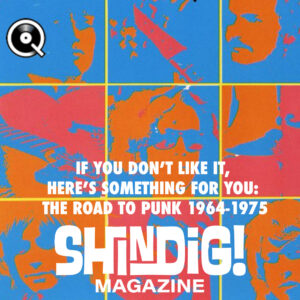Exclusive Shindig! Qobuz playlist #11: If You Don’t Like It, Here’s Something For You: The Road To Punk 1964-1975
We’re very excited to be media partners with the truly unique online streaming platform and download store Qobuz. The 11th of our monthly bespoke playlists, which take in all manner of genres and sub-genres, scenes and beyond, then and now, takes a look at the road travelled to punk

Play here or use the scrollable frame with tracklist the bottom of the page. You can sign up for a free trial today. Plans start from £10.83 per month. For more on Qobuz read our interview with MD Dan Mackta here
There’s been a lot written on proto-punk. Countless musicologists have penned thought pieces on the overriding importance ‘Louie Louie’ and ‘You Really Got Me’ had on everything nihilistic that followed in Year Zero. Some have taken it back even further, citing Johnny Burnette’s ‘The Train Kept A-Rollin’’, the nonchalant Gene Vincent, and mean ’n’ moody instrumentalist Link Wray as punk catalysts. The Pretty Things made the Stones look like compliant young men, West Country yobs The Troggs were far too lewd for their own good, and Van Morrison, whilst singing in Them, was caked in snot. Surely, ‘Gloria’ ranks as one of the proto-punk classics, so brilliantly interpreted by Patti Smith, whose guitarist Lenny Kaye was no slouch when it came to chronicling the roots of punk. He was a flag waver that inspired. So, it is with a score of Nuggets-esque type teen-punk from the mid to late ’60s that we start our Shindig! take on the evolution of punk music. New England’s Rockin’ Ramrods were relatively clean cut and preppie on the whole, but ‘She Lied’ sounds exactly like the starting point for the class of ’76 in London. Perhaps Ted Carroll sold a few young oiks copies. New Zealand’s The Blue Stars nailed the punk credential to the mast with ‘Social End Product’, as did Texan’s Nobody’s Children’s ‘Good Times’, which even at the height of the hippie movement was utterly misanthropic. Also from Texas were the freeform freaks The Red Crayola. The art-punks loved ‘Hurricane Fighter Plane’ so much that it gained a reissue in 1978, and was clearly a pointer for all intelligent scratchy guitar bands.
The garage band era was definitely punk. The otherwise psychedelic The Elastik Band took Captain Beefheart and Zappa to extremes on the utterly offensive, but somehow wonderful, ‘Spazz’. None of these early pioneers thought of themselves as punk. They just were.
Many of the Detroit area acts that started off in teenbeat bands, like Iggy Pop with The Iguanas, morphed into something new for the later ’60s, with The MC5, The Up, and of course, The Stooges. The bands which many consider as the true starting point of the punk movement. But across Europe seemingly typical long-haired bands were appropriating a proto-punk sound quite by accident, take Sweden’s T-Boones, who under the influence of Jimi Hendrix , turn The Troggs’ horny ‘I Want You’ into something far more threatening, and London-based Northern Irish band Andwella’s Dream’s punkish ‘Sunday’, which featured on the flip of their debut single.
Ladbroke Grove in London was the home of Mick Farren and his Deviants. The area’s freak scene featured a number of bands who looked like heads and enjoyed their environs but were angry and socially aware. Their music made quite an impact. ‘Slum Lord’ from The Deviants’ second album, 1968’s Disposable, definitely pointed towards key punk themes, as did Hawkwind’s ‘Urban Guerilla’, a single from ’73. The Pink Fairies’ ‘Do It’ may be this unwashed scene’s ultimate war cry. The Ladbroke freak scene somehow even made its way to Texas. The Stereo Shoestring’s rewrite of The Pretty Things’ ‘Defecting Grey’, with the Syd-like trippy bits excised, leaving the gnarly fuzz riff and new lyrics, is a heavy hallucinatory nightmare. Conservative Texas got punk. In Canada, the delightfully named It’s Meat issued ‘Feel It’. Acid munching Californian freaks Blue Cheer went fuzz-punk on ‘Come And Get It’. Sky Saxon with a new version of The Seeds went to the ‘Bad Part Of Town’. And don’t forget Alice Cooper. Choppers, fights, leather… Altamont violence. The music reflected the changing times from peace and love into something darker. And however terrible that tumultuous time was, the nasty music oozed a proto-punk dirtiness fuelled by cheap beer and bad narcotics.
Meanwhile, back in the UK, Shropshire had beastly hairy behemoths Stack Waddy signed by John Peel on his Dandelion label. Their terrifying version of the Pretties’ ‘Rosalyn’, like Northants lads Wicked Lady’s ‘I’m A Freak’, epitomised what we now call “Freakrock”, a term which the sadly deceased Shindig! writer Rex Thompson termed in 2002. Hard, heavy and glam were the norm in the early ’70s, but certain bands or songs, just went that bit further. Hello’s ‘Hello Hooray’ was bovver boy all the way. Third World War’s ‘Working Class Man’ may have been the first entrant into street-punk, while French headbangers Rotomagus’ ‘Fightin’ Cock’, out did Motörhead, all the way back in 1971, in the punk-metal stakes.
We probably know how much The Damned loved The Pink Fairies and Johnny Rotten Can, but let’s not overlook the utter importance of Mott The Hoople’s 1971 punker ‘Death May Be Your Santa Clause’. Ian Hunter’s vocals definitely caught Lydon’s ear. The Hammersmith Gorillas were playing to future punks and were watched closely. Their take on ‘You Really Got Me’ is dumb, moronic and was clearly chipping away at the complex musical facade of the dinosaurs.
The arrival of The New York Dolls was beyond important, acts like Streak, Rosie, The Hollywood Brats, and many more drunk heartily from their cup, and Malcolm McLaren was scheming something big. But it wasn’t all sensation-seeking and making a statement. Rock ’n’ roll was massive in the ’70s, and indeed McLaren initially sold drapes to working class Teddy boys. US act The Flamin’ Groovies, who would later move to the UK, cut the Grease EP in 1973. The roots of this were vintage rock ’n’ roll, but the outlook was closer to punk. As was The Count Bishops’ ‘Teenage Letter’, sang by Brooklyn transplant Mike Spenser, and the highly influential Doctor Feelgood’s ‘Roxette’.
Before we end up with the early punk of Death’s ‘Freakin’ Out’, Canada’s Simply Saucer’s on target ‘Nazi Apocalypse’, The Electric Eels’ ‘Agitated’, comes the uncategorisable Zolar-X and their punk/glam ‘Space Age Love’, the basement rock of George Brigman, punk/metal of Pinnacle, and NYC’s wrestling street-punk’s The Dictators.
All of this music was made over a nine-year period, which is incredible. Whether it’s The Ramones’ ‘Blitzkrieg Bop’ or The Damned’s ‘New Rose’ you consider the first record of the punk-rock era, an awful lot of music that ticked the same boxes had been made for a number of years, and the class of ’76 were very aware.
© Jon ‘Mojo’ Mills /Shindig! magazine in partnership with Qobuz

